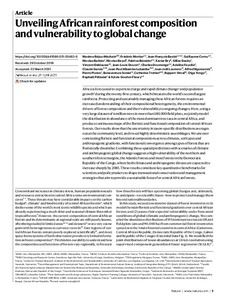| dc.contributor.author | Rejou-Machain, M. |
| dc.contributor.author | Mortier, F. |
| dc.contributor.author | Bastin, J.F. |
| dc.contributor.author | Cornu, G. |
| dc.contributor.author | Barbier, N. |
| dc.contributor.author | Bayol, N. |
| dc.contributor.author | Benedet, F. |
| dc.contributor.author | Bry, X. |
| dc.contributor.author | Dauby, G. |
| dc.contributor.author | Deblauwe, V. |
| dc.contributor.author | Doucet, J.L. |
| dc.contributor.author | Doumenge, C. |
| dc.contributor.author | Fayolle, A. |
| dc.contributor.author | Garcia, C. |
| dc.contributor.author | Lubamba, J.P.K. |
| dc.contributor.author | Loumeto, J.J. |
| dc.contributor.author | Ngomanda, A. |
| dc.contributor.author | Ploton, P. |
| dc.contributor.author | Sonke, B. |
| dc.contributor.author | Trottier, C. |
| dc.contributor.author | Vimal, R. |
| dc.contributor.author | Yongo, O. |
| dc.contributor.author | Pelissier, R. |
| dc.contributor.author | Gourlet-Fleury, S. |
| dc.date.accessioned | 2021-05-10T09:34:08Z |
| dc.date.available | 2021-05-10T09:34:08Z |
| dc.date.issued | 2021 |
| dc.identifier.citation | Réjou-Méchain, M., Mortier, F., Bastin, J.F., Cornu, G., Barbier, N., Bayol, N., ... & Gourlet-Fleury, S. (2021). Unveiling African rainforest composition and vulnerability to global change. Nature, 1-28. |
| dc.identifier.issn | 0028-0836 |
| dc.identifier.uri | https://hdl.handle.net/20.500.12478/7118 |
| dc.description.abstract | Africa is forecasted to experience large and rapid climate change1 and population growth2 during the twenty-first century, which threatens the world’s second largest rainforest. Protecting and sustainably managing these African forests requires an increased understanding of their compositional heterogeneity, the environmental drivers of forest composition and their vulnerability to ongoing changes. Here, using a very large dataset of 6 million trees in more than 180,000 field plots, we jointly model the distribution in abundance of the most dominant tree taxa in central Africa, and produce continuous maps of the floristic and functional composition of central African forests. Our results show that the uncertainty in taxon-specific distributions averages out at the community level, and reveal highly deterministic assemblages. We uncover contrasting floristic and functional compositions across climates, soil types and anthropogenic gradients, with functional convergence among types of forest that are floristically dissimilar. Combining these spatial predictions with scenarios of climatic and anthropogenic global change suggests a high vulnerability of the northern and southern forest margins, the Atlantic forests and most forests in the Democratic Republic of the Congo, where both climate and anthropogenic threats are expected to increase sharply by 2085. These results constitute key quantitative benchmarks for scientists and policymakers to shape transnational conservation and management strategies that aim to provide a sustainable future for central African forests. |
| dc.format.extent | 1-28 |
| dc.language.iso | en |
| dc.subject | Climate Change |
| dc.subject | Rain Forests |
| dc.subject | Biodiversity Conservation |
| dc.subject | Botanical Composition |
| dc.subject | Vulnerability |
| dc.title | Unveiling African rainforest composition and vulnerability to global change |
| dc.type | Journal Article |
| cg.contributor.crp | Agriculture for Nutrition and Health |
| cg.contributor.affiliation | Université de Montpellier |
| cg.contributor.affiliation | Centre de Coopération Internationale en Recherche Agronomique pour le Développement |
| cg.contributor.affiliation | University of Liège |
| cg.contributor.affiliation | Formation Professionnelle, France |
| cg.contributor.affiliation | University of California |
| cg.contributor.affiliation | International Institute of Tropical Agriculture |
| cg.contributor.affiliation | Institute of Integrative Biology, Switzerland |
| cg.contributor.affiliation | Université de Kinshasa |
| cg.contributor.affiliation | Wildlife Conservation Society, Democratic Republic of the Congo |
| cg.contributor.affiliation | Université Marien Ngouabi |
| cg.contributor.affiliation | Institut de Recherche en Écologie Tropicale, Gabon |
| cg.contributor.affiliation | University of Yaoundé 1 |
| cg.contributor.affiliation | Universite Paul Valéry Montpellier |
| cg.contributor.affiliation | Université Jean-Jaurès |
| cg.contributor.affiliation | Université de Bangui |
| cg.coverage.region | Africa |
| cg.coverage.region | Central Africa |
| cg.coverage.country | Democratic Republic of the Congo |
| cg.coverage.hub | Central Africa Hub |
| cg.researchtheme | Natural Resource Management |
| cg.identifier.bibtexciteid | REJOUMECHAIN:2021 |
| cg.isijournal | ISI Journal |
| cg.authorship.types | CGIAR and developing country institute |
| cg.iitasubject | Climate Change |
| cg.iitasubject | Forestry |
| cg.iitasubject | Natural Resource Management |
| cg.journal | Nature |
| cg.notes | Published online: 21 Apr 2021 |
| cg.accessibilitystatus | Limited Access |
| cg.reviewstatus | Peer Review |
| cg.usagerightslicense | Copyrighted; all rights reserved |
| cg.targetaudience | Scientists |
| cg.identifier.doi | https://dx.doi.org/10.1038/s41586-021-03483-6 |
| cg.iitaauthor.identifier | Vincent Deblauwe: 0000-0001-9881-1052 |
| cg.futureupdate.required | No |
| cg.contributor.acknowledgements | We thank the 105 forest companies that provided access, albeit restricted, to their inventory data for research purposes and members of the central African plot network (https://central-african-plot-network.netlify.app/), Y. Yalibanda, F. Allah-Barem, F. Baya, F. Boyemba, M. Mbasi Mbula, P. Berenger, M. Mazengue, V. Istace, I. Zombo, E. Forni, Nature+ and the CEB-Precious Woods company for giving access to the scientific inventories described in Supplementary Fig. 4, some of which were funded by the AFD and the FFEM (for example, DynAfFor and P3FAC projects). We thank J. Chave, P. Couteron, S. Lewis and M. Tadesse for their comments and discussions on previous versions, B. Sultan for useful discussions on climate projections, O. J. Hardy for advice on phylogenetical analyses, B. Locatelli for advice on vulnerability analyses, G. Vieilledent for discussions on the human-induced forest-disturbance intensity index and A. Stokes for English editing. This work was supported by the CoForTips project (ANR‐12‐EBID‐0002) funded by the ERA-NET BiodivERsA, with the national funders ANR, BELSPO and FWF, as part of the 2012 BiodivERsA call for research proposals, the GAMBAS project funded by the French National Research Agency (ANR-18-CE02-0025) and the project 3DForMod funded by the UE FACCE ERA-GAS consortium (ANR-17-EGAS-0002-01). This study is a contribution to the research program of LMI DYCOFAC (Dynamique des écosystèmes continentaux d’Afrique Centrale en contexte de changements globaux). |

